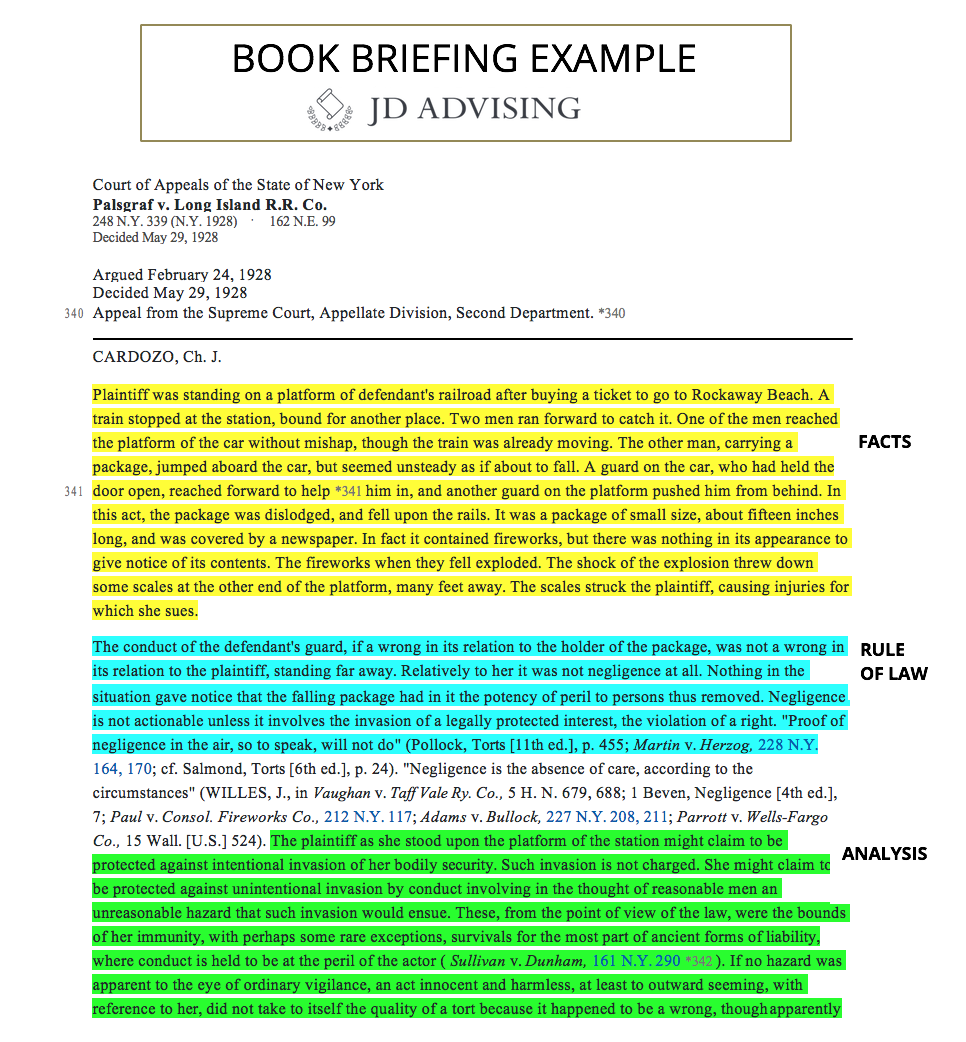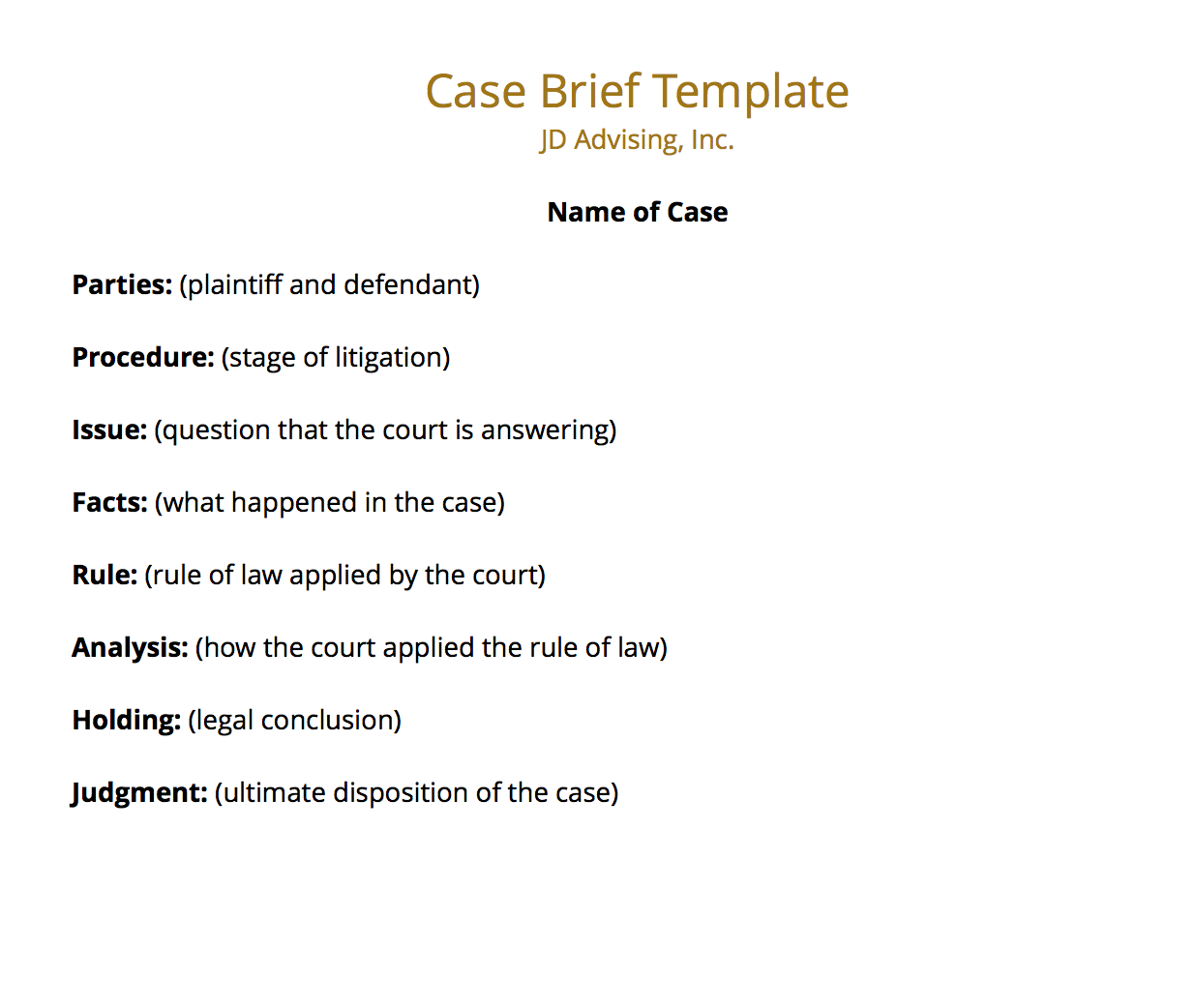How do I brief a case?
How do I brief a case?
A very important skill that a first-year law student learns is the art of “briefing” an assigned case. A case brief is essentially a roadmap of a legal opinion, and it provides a few critical benefits. So, it is a good exercise to brief cases when you first start reading them. (Note: We recommend a better strategy for briefing cases.)
What are the benefits of briefing cases at first?
First, a case brief serves as a way to refresh your memory on key information from a case that you may have read several days before class (and months before an exam). This certainly comes in handy if you’re called on in class, but it also helps you follow along with the class discussion and can be an effective study tool come exam time. Second, and equally important, the practice of briefing cases is an active study technique that helps you learn how to read a legal opinion. Specifically, you learn—among other things—how to spot the legal issue, recognize legally significant facts, identify the rule of law, and understand the court’s reasoning.
Briefing a case is the first step to learning how to think like a lawyer so that you’ll eventually be able to dissect a legal opinion and identify the relevant portions simply by reading it. Here, we’ll discuss the anatomy of a case brief and explain the basics of how to create one.
How to brief a case in law school
The anatomy of a case brief is fairly straightforward. It generally consists of the following components: procedure, issue, facts, rule, analysis/application, holding, and judgment. A brief may also include, where appropriate, policy and dicta. For a case brief template with detailed descriptions of each section, along with a sample case brief, see the next chapter of the guide here.
Once you understand the basics of a case brief template, the question then becomes: Where to start?
Strong case briefing begins with strong case reading. Reading a legal opinion is a vastly different experience from reading a casual novel or newspaper article. Opinions—especially older ones—are often written in technical jargon and can be difficult to follow at first. Fortunately, judges today seem to be endeavoring to make their writings more understandable and accessible to the educated lay public. Chief Justice Roberts is a shining example of this. As a law student, however, you should be prepared to read cases written over two centuries ago.
With that said, here are a few tips on how to read a legal opinion.
1. Read slowly
If you try to read too quickly, you might miss crucial information, or you might struggle with comprehending a complex point. Take your time and try to understand as you read. Many students find it helpful to look up legal vocabulary they do not know as they go along.
2. Don’t be afraid to read the opinion more than once
Some law professors even recommend reading a case once through to get the gist of the case, and a second time through to gain a more detailed understanding. The bottom line is that you want to come away from the case feeling confident that you could explain the case and the court’s reasoning to a layperson, classmate, or professor.
3. Read actively
Be prepared to mark up the opinion. As you read the opinion, identify and note the components discussed above. Some students prefer to do this by underlining or highlighting with different colored pens or highlighters. For example, you might choose to mark procedural information in pink, the legal issue in yellow, the facts in orange, and so on. Other students prefer to use a single color pen and mark up the case in the margins. For example, you can write “P” next to procedural information, “I” next to the issue, “F” next to the facts, and so on.
4. Write your brief
Once you’ve read and marked up the case, it’s now time to write the actual brief. (Again, we do not recommend doing this for every case, but it is helpful to do when you first start law school.) You can start with the template discussed above in either a word processing document or on paper in a notebook. Your goal should be to limit your brief to one single-sided page, or better yet, a half-page. This may be difficult at first, but with practice, you’ll find yourself becoming more efficient and more concise.
Although many students today tend to type up their case briefs on a computer, there are definite advantages to handwriting your briefs. When you type a brief, it’s easier to simply transcribe text from the opinion and end up with a fairly long, multi-page brief—much longer than what you are aiming for. When you handwrite, on the other hand, you’ll be more thoughtful about what you choose to write down, and this requires you to mentally separate what is and what is not important. Further, there’s a substantial body of psychological research suggesting that students who handwrite notes exhibit greater comprehension and retention of the material that they are learning. While typing may seem faster and more efficient, handwriting your case briefs is something that you should at least try.
What is book briefing?
You may hear some students mention “book briefing.” This is essentially a heavy annotation of a case in the casebook—i.e., you identify the key portions of the case, and you add notes in the margins to aid you during class and in your studying.
For example:
- Write “FACTS” next to the facts in your casebook (or highlight the facts in whatever color you have designated for facts!).
- Write “RULE” next to the rule in your casebook.
- Note the procedural history, holding, rationale, and other key points in your casebook either by writing these words or color-coding your casebook, as noted above.
An example is below:

Book briefing is much less time consuming than case briefing. So we recommend you switch to this method as soon as possible.
The best way to become an effective case briefer or book briefer is with practice, practice, and . . . more practice. So grab a pen, some fresh highlighters, and your casebook, and give it a try!
Go to the next topic, What is an example of a law school case brief template?
Seeking Success in Law School?
- Benefit from personalized one-on-one tutoring by our seasoned law school tutors.
- Explore our NEW and highly acclaimed law school study aids, available for a free trial.










Leave a Reply
Want to join the discussion?Feel free to contribute!